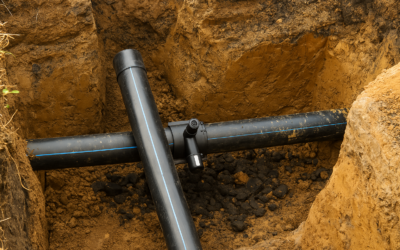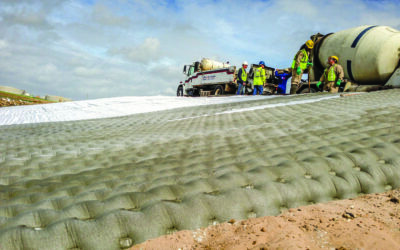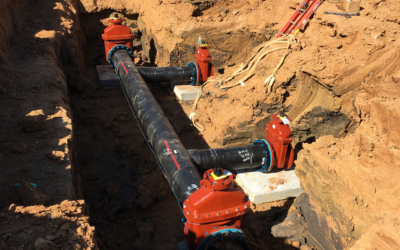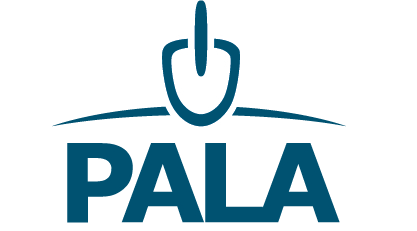In the specialty construction space, there’s a lot of talk about the best materials for a job, and for good reason. No matter your industry or use case, performance matters, and selecting the right solution for your specific application can make or break your construction project. This conversation is particularly important when it comes to piping, in part because you may not know the difference between the two key players: HDPE and PVC.
But HDPE and PVC pipe have some important differences when it comes to performance, installation methods, and applications. Keep reading to learn more about the differences between PVC and HDPE pipe and the implications for specialty construction.
HDPE vs. PVC Pipe: Material Differences
HDPE pipe is made of high-density polyethylene, a thermoplastic polymer that’s malleable at high temperatures. It is created by linking ethylene molecules, which are derived from natural gas.
HDPE has a high strength-to-density ratio and is corrosion-resistant, making it an extremely versatile and cost-effective material. In fact, HDPE is the most widely used type of plastic today.
PVC pipe is made of vinyl, not plastic. Specifically, it’s made of polyvinyl chloride, which is created by reacting monomer molecules of vinyl chloride to form a polymer, then adding plasticizing substances to increase the flexibility and other performance characteristics.
PVC has a high level of hardness and is resistant to corrosion. Depending on the formulation of the PVC, it can have better thermal performance than HDPE. PVC pipe is generally rigid, whereas HDPE has greater flexibility.
Joining Methods for HDPE and PVC Pipe
The methods of joining sections of pipe differ for PVC and HDPE.
PVC pipe, being rigid, is generally joined using solvent cements. These cements glue the pieces of pipe together by melting the adjoining surfaces of the pipe to each other. A particular benefit of this method of pipe joining is that it can be performed underwater.
A specific type of PVC, Fusible PVC®, can be joined with a specialized thermal butt fusion technology. This gives it an advantage over other types of PVC, especially in installation environments that are more difficult to work in. It also offers more durable performance and extended lifespans.
HDPE pipe is joined using plastic fusion, wherein the plastic of each pipe being joined is melted together under extreme heat. This results in seamless, leak-free joints between pipes.
Installation Methods for HDPE and PVC Pipe
PVC pipe can only be installed using open trench or drop burial methods. Additionally, it must be carefully installed to ensure that the pipe does not crack longitudinally or fail due to overbelling—a condition that occurs when a receiving pipe is not properly sized or fitted to the adjoining pipe, resulting in pipe bursting or breaking or leaking at the joint.
Fusible PVC® is the exception. Because of its unique thermal butt fusion joining technology, it’s built for streamlined, trenchless installations using horizontal directional drilling or sliplining.
When it comes to installation methods, HDPE pipe outperforms PVC pipe because it is more versatile. HDPE pipe can be installed via drop burial or open trench installation, but it can also be installed using horizontal directional drilling or sliplining. Depending on the application, these methods can be more time- or cost-effective.
Durability and Lifespan: Which Material Lasts Longer?
According to research by the Plastic Pipe Institute, HDPE pipe can exceed the conservative 50-year life expectancy generally assigned to it and can have a lifespan of over 100 years. A recent study has also found that PVC pipe can have a projected lifespan of 100 years, making both extremely long-lasting pipe materials.
HDPE, however, is most often the more durable material. Due to the flexibility of the material and the leak-free fusion joints, HDPE is better able to withstand impact, stress, and weather than its more rigid counterpart. PVC has potential, but only Fusible PVC® can truly compete with HDPE.
Applications
HDPE and PVC piping have many overlapping uses, as well as some uses specific to each type of pipe, due to their differing performance characteristics.
| Applications for HDPE and PVC Pipe | |
| HDPE Pipe | PVC Pipe |
|
Water mains Gas mains Sewage Stormwater and drainage Irrigation Slurry transfer Electrical and communications conduit Mining Firewater Ocean cleanup Outfall Lines Brine Lines Process Chemicals |
Water mains Household plumbing Sewage Stormwater and drainage Irrigation Chemicals Exhaust and fumes Underwater piping |
HDPE vs. PVC for Specialty Construction
For specialty construction, HDPE pipe is the right choice for most applications. There are some occasions where PVC, especially Fusible PVC®, is best, but HDPE ultimately reigns champ. It’s a durable, long-lasting, and flexible material that balances performance considerations with cost-effectiveness.
For most specialty construction use cases, the heat tolerance of HDPE pipe is perfectly adequate to the application, and the added cost and time savings from installation via sliplining or other innovative methods is a serious benefit.
Both HDPE pipe and PVC offer a flexible, durable, cost-effective solution for a variety of specialty construction applications. If you’re hoping to implement a piping solution in your next project, contact US FUSION. We have a complete line of products, in various sizes and configurations, so you can get the results you need.







